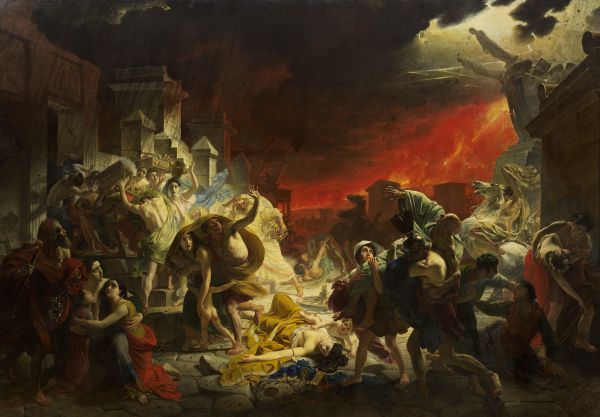|
|
The Last Day of Pompeii. 1833

Brullov Karl,
Oil on сanvas
456,5 x 651
State Russian Museum
Пост. в 1897 из ИЭ; ранее (до 1851) - в ИАХ; ранее - в собр. А.Н. Демидова (подарена императору Николаю I, который в 1836 передал ее в ИАХ)
Annotation
The subject of the canvas is the destruction of the ancient Roman town of Pompeii during an eruption of the volcano Vesuvius in the year 79 AD. Brullov’s historical sources were the letters written by the ancient Roman historian Pliny the Younger, a witness of the catastrophe, to Tacitus, and a study of the ruins of Pompeii, where archaeological excavations had begun in the middle of the eighteenth century. The scene of the action is the Strada dei Sepolcri (Road of Tombs), the Pompeii necropolis and a kilometre perspective from the Gates of Hercules to the Villa Diomedes in the direction of the Villa of Mysteries. The Last Day of Pompeii was exhibited at the Pinacoteca di Brera in Milan in 1833. It was then sent to the annual Paris Salon, which had opened in the Louvre in March 1834, winning Brullov a first gold medal. The painting was shown at the Imperial Hermitage in St Petersburg in 1834 and at a special exhibition organized by the Imperial Academy of Arts in 1835. Among the characters in the painting, Brullov depicts himself (the artist on the steps of the temple) and Countess Yulia Samoilova (the mother embracing her daughter).
Author's Biography
Brullov Karl
Brullov (Bruleau), Karl Pavlovich
1799, St Petersburg -1852, Manziana (near Rome)
Painter, watercolourist, draughtsman, history painter, portraitist, genre painter, mural painter. Born into an artistic family. Studied under Anton Ivanov, Alexei Yegorov and Vasily Shebuyev at the Imperial Academy of Arts (1809-22), graduated with a first-class gold medal. Sent to Italy by the Society for the Encouragement of Arts (1822-35). Worked in Milan, Naples and Rome. Won fame in Europe as a portraitist and history painter for such works as The Last Day of Pompeii (1827-33, Russian Museum. St Petersburg)- Returned to Russia and lived in St Petersburg. Honorary freeman (1834), second-degree professor (1835) and first-degree professor (1846) of the Imperial Academy of Arts, where he taught history painting, enjoying the love and respect of his many students. Professor of the Accademia di Belle Arti in Florence. Contributed to exhibitions in Rome, Milan, Paris and St Petersburg. Went abroad on the advice of doctors (1849), settled in Italy (1850).

